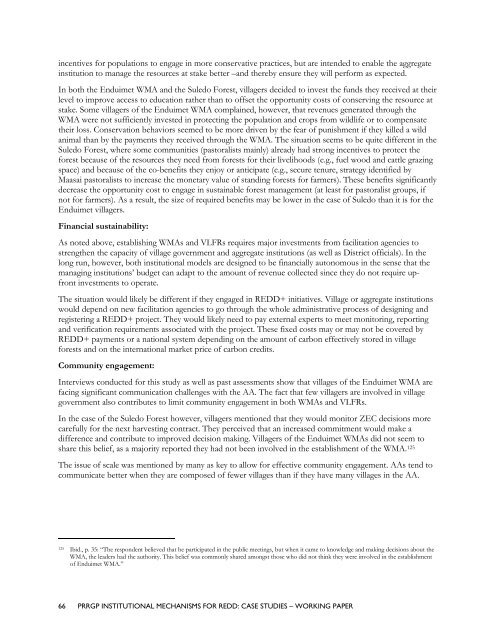Institutional Mechanisms for REDD+ - Case Studies Working Paper
Institutional Mechanisms for REDD+ - Case Studies Working Paper
Institutional Mechanisms for REDD+ - Case Studies Working Paper
Create successful ePaper yourself
Turn your PDF publications into a flip-book with our unique Google optimized e-Paper software.
incentives <strong>for</strong> populations to engage in more conservative practices, but are intended to enable the aggregate<br />
institution to manage the resources at stake better –and thereby ensure they will per<strong>for</strong>m as expected.<br />
In both the Enduimet WMA and the Suledo Forest, villagers decided to invest the funds they received at their<br />
level to improve access to education rather than to offset the opportunity costs of conserving the resource at<br />
stake. Some villagers of the Enduimet WMA complained, however, that revenues generated through the<br />
WMA were not sufficiently invested in protecting the population and crops from wildlife or to compensate<br />
their loss. Conservation behaviors seemed to be more driven by the fear of punishment if they killed a wild<br />
animal than by the payments they received through the WMA. The situation seems to be quite different in the<br />
Suledo Forest, where some communities (pastoralists mainly) already had strong incentives to protect the<br />
<strong>for</strong>est because of the resources they need from <strong>for</strong>ests <strong>for</strong> their livelihoods (e.g., fuel wood and cattle grazing<br />
space) and because of the co-benefits they enjoy or anticipate (e.g., secure tenure, strategy identified by<br />
Maasai pastoralists to increase the monetary value of standing <strong>for</strong>ests <strong>for</strong> farmers). These benefits significantly<br />
decrease the opportunity cost to engage in sustainable <strong>for</strong>est management (at least <strong>for</strong> pastoralist groups, if<br />
not <strong>for</strong> farmers). As a result, the size of required benefits may be lower in the case of Suledo than it is <strong>for</strong> the<br />
Enduimet villagers.<br />
Financial sustainability:<br />
As noted above, establishing WMAs and VLFRs requires major investments from facilitation agencies to<br />
strengthen the capacity of village government and aggregate institutions (as well as District officials). In the<br />
long run, however, both institutional models are designed to be financially autonomous in the sense that the<br />
managing institutions‘ budget can adapt to the amount of revenue collected since they do not require upfront<br />
investments to operate.<br />
The situation would likely be different if they engaged in <strong>REDD+</strong> initiatives. Village or aggregate institutions<br />
would depend on new facilitation agencies to go through the whole administrative process of designing and<br />
registering a <strong>REDD+</strong> project. They would likely need to pay external experts to meet monitoring, reporting<br />
and verification requirements associated with the project. These fixed costs may or may not be covered by<br />
<strong>REDD+</strong> payments or a national system depending on the amount of carbon effectively stored in village<br />
<strong>for</strong>ests and on the international market price of carbon credits.<br />
Community engagement:<br />
Interviews conducted <strong>for</strong> this study as well as past assessments show that villages of the Enduimet WMA are<br />
facing significant communication challenges with the AA. The fact that few villagers are involved in village<br />
government also contributes to limit community engagement in both WMAs and VLFRs.<br />
In the case of the Suledo Forest however, villagers mentioned that they would monitor ZEC decisions more<br />
carefully <strong>for</strong> the next harvesting contract. They perceived that an increased commitment would make a<br />
difference and contribute to improved decision making. Villagers of the Enduimet WMAs did not seem to<br />
share this belief, as a majority reported they had not been involved in the establishment of the WMA. 125<br />
The issue of scale was mentioned by many as key to allow <strong>for</strong> effective community engagement. AAs tend to<br />
communicate better when they are composed of fewer villages than if they have many villages in the AA.<br />
125 Ibid., p. 35: ―The respondent believed that he participated in the public meetings, but when it came to knowledge and making decisions about the<br />
WMA, the leaders had the authority. This belief was commonly shared amongst those who did not think they were involved in the establishment<br />
of Enduimet WMA.‖<br />
66 PRRGP INSTITUTIONAL MECHANISMS FOR REDD: CASE STUDIES – WORKING PAPER

















